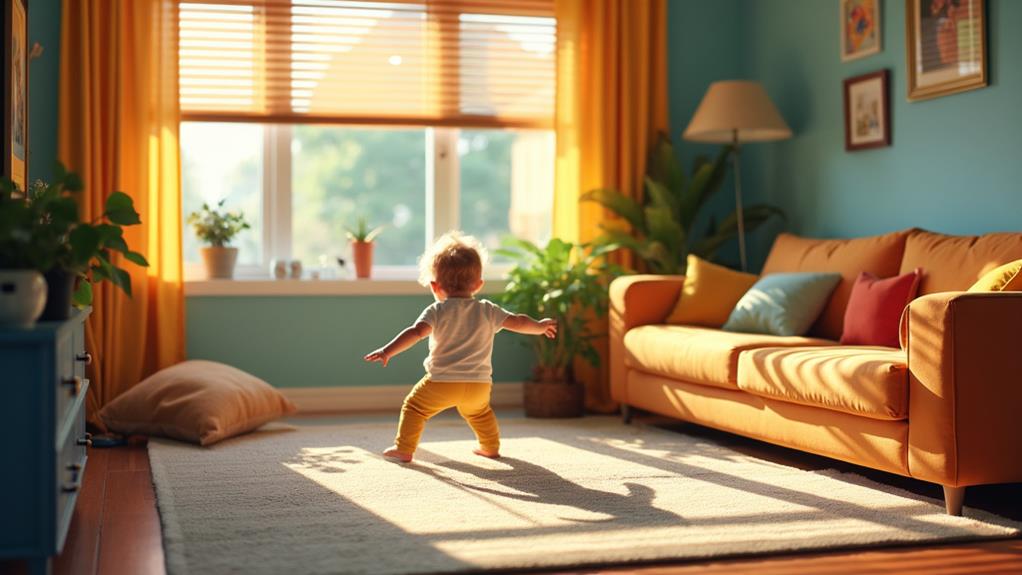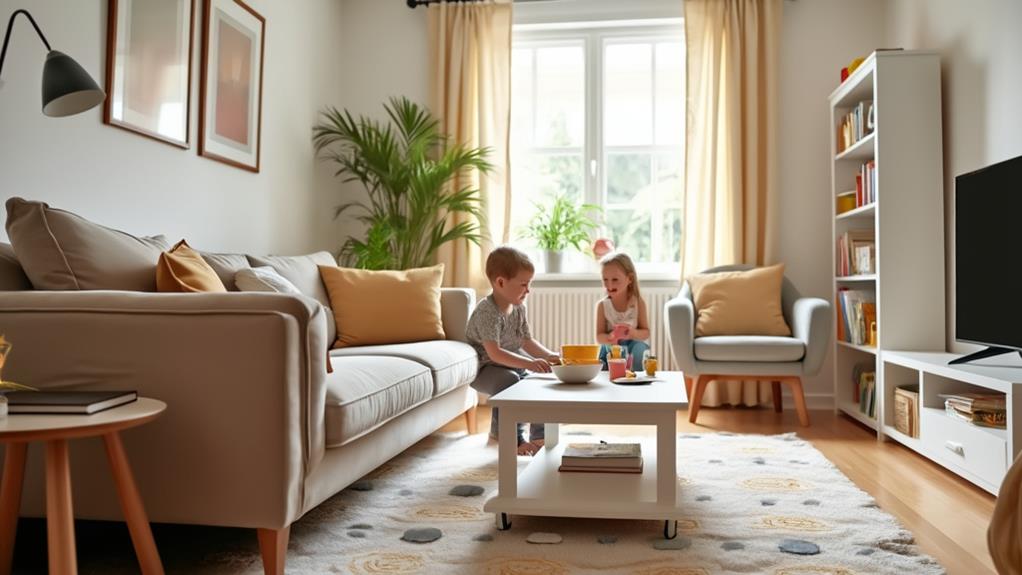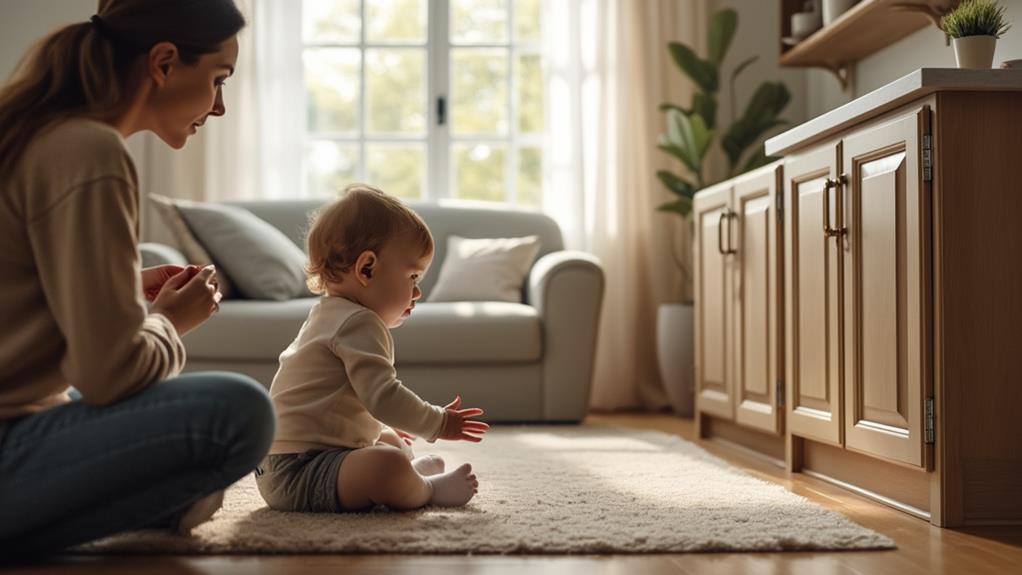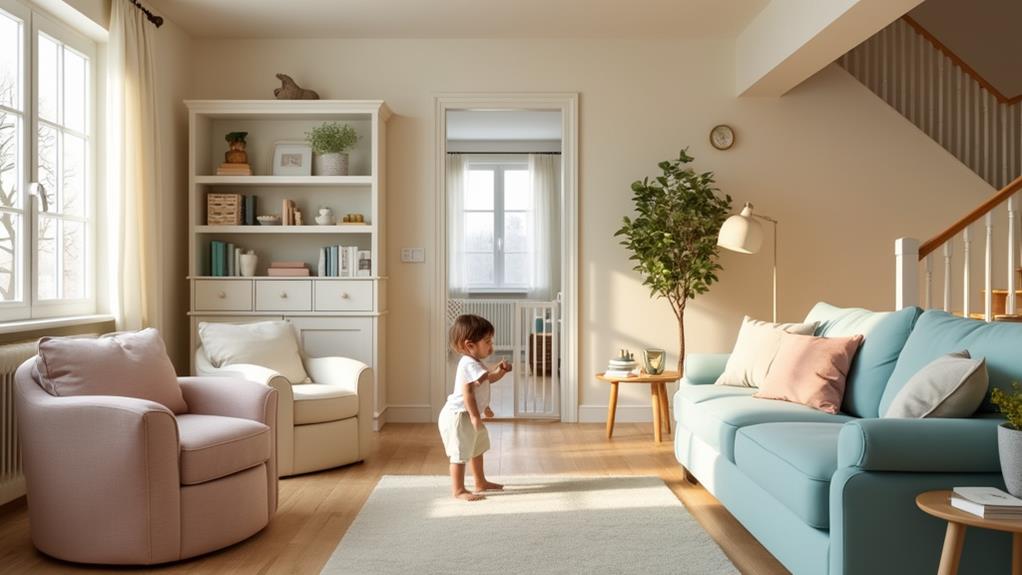Childproofing your home involves multiple strategies to guarantee safety for your curious child. Start by securing heavy furniture with wall anchors, thereby preventing tipping incidents. Inspect and relocate climbable items, making sure they aren't near windows, and install locks to enhance security. Door stoppers and knob covers effectively prevent injuries and limit access to hazardous areas. Protect furniture edges with foam or rubber guards, prioritizing non-toxic materials. Regularly inspect these elements to maintain their effectiveness as your child grows. Active supervision remains vital, but you can explore additional resources for a thorough approach to sustaining a safe environment.
Table of Contents
ToggleImportance of Childproofing

Childproofing is vital for creating a safe home environment where children can explore and play without constant risk of injury. By implementing proactive measures, you greatly reduce accidents and injuries related to furniture.
Understanding the risks associated with various furniture types is essential. Regular inspections for hazards, such as sharp edges and dangling cords, help maintain safety.
As your child grows, their needs and abilities change, requiring you to adapt your childproofing strategies accordingly. This approach not only contributes to peace of mind for families but also fosters a secure environment that encourages exploration.
Prioritizing childproofing guarantees that your home remains a safe space where children can thrive, minimizing potential dangers and enhancing overall family well-being.
Securing Heavy Furniture
When it comes to securing heavy furniture, safety should be your top priority.
Begin by identifying pieces at risk of tipping, such as tall bookcases or dressers. Use wall anchors or brackets to secure these items firmly in place, following the manufacturer's instructions meticulously to guarantee effectiveness.
Regular inspections are essential, as they allow you to adjust and tighten connections as needed, keeping safety measures up-to-date.
Consider these important steps:
- Identify risk-prone furniture: Look for tall, top-heavy items.
- Use wall anchors or brackets: Secure furniture to walls, preventing tipping.
- Conduct regular inspections: Verify stability as your child grows.
Managing Furniture Risks

Securing heavy furniture is just one aspect of ensuring your home's safety, but managing additional furniture risks requires equal attention.
Begin by inspecting your home for climbable furniture, such as bookshelves or dressers, which can tempt adventurous children. Relocate these items away from windows to prevent potential falls, and use window locks to further enhance safety.
Consider the placement of furniture, ensuring it doesn't block pathways or create tripping hazards. Regularly check for loose or unstable elements within your furniture, tightening screws and securing parts as needed.
Be mindful of furniture that may contain small parts, like knobs or handles, which could pose choking hazards. By diligently managing these risks, you can create a safer environment for your child.
Protecting Furniture Edges
Guaranteeing safety in your home often starts with vigilance, especially when it comes to protecting furniture edges. Sharp corners pose a significant risk to young children, and taking proactive steps is vital.
Installing corner protectors can effectively reduce the risk of injury. These protectors, typically made from foam or rubber, absorb impacts, making them ideal for covering sharp edges. Choose non-toxic materials to guarantee safety, and always follow installation instructions, which usually involve cleaning the surface and using adhesive backing for secure placement.
Regular inspections are essential to verify the protectors remain properly attached.
Here are a few options to contemplate:
- Foam corner protectors: Soft, impact-absorbing material.
- Rubber edge guards: Durable, flexible, and safe.
- Adhesive-backed protectors: Easy to install and remove.
Locking Mechanisms

Locking mechanisms play a critical role in safeguarding your home, especially when it comes to keeping curious children away from hazardous items stored in drawers and cabinets.
To effectively childproof these areas, consider using magnetic, adhesive, or sliding locks. Magnetic locks, installed inside drawers or cabinets, require a magnetic key to open, offering an invisible yet effective barrier.
Adhesive locks are straightforward to install, sticking directly onto surfaces without the need for tools. Sliding locks, ideal for double-door cabinets, prevent doors from opening unless manually removed.
It's essential to regularly test these locks to verify they remain functional. Follow the manufacturer's guidelines during installation and maintenance, ensuring that the mechanisms provide consistent security and adapt to your child's growing curiosity and abilities.
Door Safety Measures
Preventing door-related injuries is an essential part of childproofing your home. Doors present numerous hazards, such as slamming and pinching fingers, which can easily be avoided with the right precautions.
Start by installing door stoppers. These devices prevent doors from slamming shut, reducing the risk of injury. Additionally, consider using door knob covers, which limit access to rooms that may not be child-friendly. Door knob covers are easy to install and can effectively restrict unsupervised entry.
Finally, secure door hinges with pinch guards to prevent fingers from being trapped in the gaps.
- Install door stoppers to prevent slamming and pinching.
- Use door knob covers to limit access to certain rooms.
- Secure door hinges with pinch guards for added safety.
Supervision and Resources

Active supervision is key to maintaining a safe environment for your children, even when you've implemented childproofing measures. Consistent oversight guarantees potential hazards are addressed promptly, and children learn about safety through observation and guidance.
Discussing safety regularly helps reinforce awareness, making children more conscious of their surroundings. Always check furniture for small parts, such as knobs and buttons, that could pose choking risks. Tighten loose items or use adhesives to secure them effectively.
For additional support, Artisan Furniture™ provides a range of childproofing solutions and safety products. You can contact them at Global Vision Direct Ltd., 2A Monck St, Westminster, London SW1P 2BQ, or call during business hours, Monday to Friday, 9 AM to 5 PM.
Stay updated on the latest safety recommendations to enhance your childproofing efforts.


